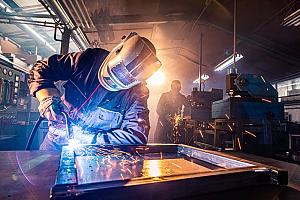Senior Editor
- FMA
- The Fabricator
- FABTECH
- Canadian Metalworking
Categories
- Additive Manufacturing
- Aluminum Welding
- Arc Welding
- Assembly and Joining
- Automation and Robotics
- Bending and Forming
- Consumables
- Cutting and Weld Prep
- Electric Vehicles
- En Español
- Finishing
- Hydroforming
- Laser Cutting
- Laser Welding
- Machining
- Manufacturing Software
- Materials Handling
- Metals/Materials
- Oxyfuel Cutting
- Plasma Cutting
- Power Tools
- Punching and Other Holemaking
- Roll Forming
- Safety
- Sawing
- Shearing
- Shop Management
- Testing and Measuring
- Tube and Pipe Fabrication
- Tube and Pipe Production
- Waterjet Cutting
Industry Directory
Webcasts
Podcasts
FAB 40
Advertise
Subscribe
Account Login
Search
Software’s amazing potential in custom metal fabrication
Metal fabrication’s relationship with software is just beginning
- By Tim Heston
- June 17, 2024

More companies on the FAB 40 are touting not just their use of robotics and automation, but also of software and data. More leaders in metal fabrication now see the connected factory as an ideal worth striving for. Traitov/iStock/Getty Images Plus
One thread of thinking made this year’s FAB 40 stand apart from previous years: software and, more broadly, the flow of information. Robotics and automation in general remain central to fabricator growth strategies, but more also are rethinking how orders flow through the office and throughout the enterprise. Today, the leading fabricators want to know—I mean, really know—what jobs are being processed, where, when, how quickly, and how well.
More than a few fabricators have adopted automated quoting platforms, several have adopted operational dashboards (like Microsoft BI) that overlay on top of ERP and other production systems, and one is using a software platform (called Guidewheel) that connects directly not to the machine but instead to the electricity feeding it. Every piece of equipment, from the latest fiber laser to the oldest press brake and simplest shop air compressor, has an electrical power-draw story to tell. Every job performed has a signature of peaks and valleys, patterns that fall in the realm of normalcy and others that show something’s amiss.
Whatever the platform, most fabricators are just starting to amp up their machine monitoring and job tracking initiatives. The puzzle will be unique for every operation, but some powerful pieces are emerging. We’ve got conventional asset tracking, with operators clocking in and out of jobs. We’ve got Industrial Internet of Things (IIoT) systems that track machine uptime and performance. We’ve got automated quoting systems, whether homegrown or third-party platforms, now built with varying degrees of DFM (design for manufacturability) intelligence. We’ve got on-the-floor part location systems, too, in which every pallet has a tag broadcasting where it is, where it has been, and when.
Imagine how each of these powerful puzzle pieces could be put together. An IIoT system connected to every piece of equipment feeds data to a production control system that correlates the information with specific jobs and job routings.
Anything out of the ordinary triggers a notification and sometimes immediate action and adaptation. Say the IIoT system detects atypical data from the press brake. Correlate that to the job information, and you soon realize that the operator chose the wrong die opening, which throws the formed piece out of tolerance—hence the unexpected work stoppage.
In typical cases, shop supervisors might just blame this on operator error; perhaps ensure tools are properly cleaned, organized, and labeled; and leave it at that. But why did the operator choose the wrong tool? Yes, he made a mistake, but the tools also weren’t where they normally should be. Where were they?
Location tracking can add to the data picture. The tools were being used on a different brake a few hours before and were placed on a tooling cart (with a location tag) that wasn’t staged in the right place.
That’s just the beginning. What if a workpiece has a hard spot that’s outside the material tolerance? The part doesn’t form properly, and the IIoT platform shows something went awry. Was it a laser cutting or punching issue? An issue with purchasing or material certification? Data from ERP, IIoT, and the nesting software (showing grid/slat location relative to cut lines) could provide some clues.
All this could really dial in not just machine utilization but also the flow of work in the entire operation, including the office and shop floor. When flow truly becomes dialed in, the sales optimization can go into hyperdrive.
At least one fabricator in the FAB 40 has plans to align marketing content with open capacity in particular machines or work centers. With enough data, marketing could focus not just on available machine capacity but also capacity on certain value streams or common job routings.
Solving problems with data
Call it AI, machine learning, or anything else, but eventually, software might get closer to solving what used to be thought as the impossible. It could schedule a high-product-mix operation that gives fabricators the best of all worlds: optimal machine and labor utilization, small batch sizes for high-velocity job flow down the value stream, and precise coordination with outside suppliers and service providers, all while maximizing throughput.
Even today, equipment downtime due to changeover remains a big drain on potential throughput. And so shops adopt a hybrid batch model, where large batches of parts are run overnight unattended, while small-batch, kit-based, or sometimes even single-piece flow operates attended during the day. Work-in-process (WIP) remains variable, sometimes high and sometimes low, depending on the variability of demand and production. And the more WIP you have, the longer it takes for a job to make it through the plant.
It’s a balancing act. Too much downtime due to changeover creates production bottlenecks at shared resources. And because fabricators nest different jobs for optimal material yield on sheet and plate, and demand varies tremendously from customer to customer, sharing equipment resources among multiple jobs is just a fact of life.
Software could refine the balancing act, especially if it uses data that connects all the disparate dots from across the shop floor. Laser uptime matters, but so does uptime at the shrink-wrapping machine in the packaging department. Or the compressor that feeds air to tools in the assembly department.
In theory, if you work to increase uptime at a machine and yet don’t ship more work out the door in less time, the flow of production isn’t perfect. You could have run that machine less and still ship the same amount of product—unless you free the constraint in the job routing, perhaps choose a different job to run … the list of variables can be extraordinarily long. It’s all so complex, but imagine a world in which software could solve this impossibly complex problem.
We’re not there yet, not by a long shot. The industry’s adoption of software and data collection in general varies widely. Getting the basics together—like standard work instructions, consistent data entry, good training, and shop organization practices—can’t be ignored either. Still, the software world continues to advance rapidly, and some important puzzle pieces are starting to be set in place. Considering how successful some fabricators already are, just imagine the potential.
subscribe now

The Fabricator is North America's leading magazine for the metal forming and fabricating industry. The magazine delivers the news, technical articles, and case histories that enable fabricators to do their jobs more efficiently. The Fabricator has served the industry since 1970.
start your free subscriptionAbout the Author

Tim Heston
2135 Point Blvd
Elgin, IL 60123
815-381-1314
Tim Heston, The Fabricator's senior editor, has covered the metal fabrication industry since 1998, starting his career at the American Welding Society's Welding Journal. Since then he has covered the full range of metal fabrication processes, from stamping, bending, and cutting to grinding and polishing. He joined The Fabricator's staff in October 2007.
- Stay connected from anywhere

Easily access valuable industry resources now with full access to the digital edition of The Fabricator.

Easily access valuable industry resources now with full access to the digital edition of The Welder.

Easily access valuable industry resources now with full access to the digital edition of The Tube and Pipe Journal.
- Podcasting
- Podcast:
- The Fabricator Podcast
- Published:
- 06/25/2024
- Running Time:
- 64:35
Matt Brunner, co-founder and co-owner of Manitowoc, Wis.-based Brunner Fabrication joins us to talk about how he transformed...
- Industry Events
Advanced Laser Application Workshop
- June 25 - 27, 2024
- Novi, MI
Precision Press Brake Certificate Course
- July 31 - August 1, 2024
- Elgin,
Laser Welding Certificate Course
- August 6 - 8, 2024
- Farmington Hills, IL
Golf 4 Manufacturing
- August 19 - 18, 2024
- Waukegan,
The Fabricator's Technology Summit
- August 20 - 21, 2024
- Eglin, IL































